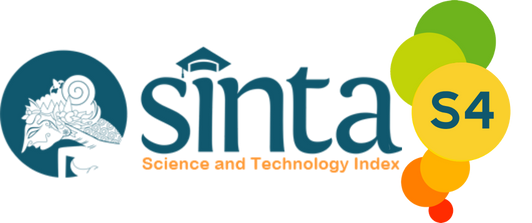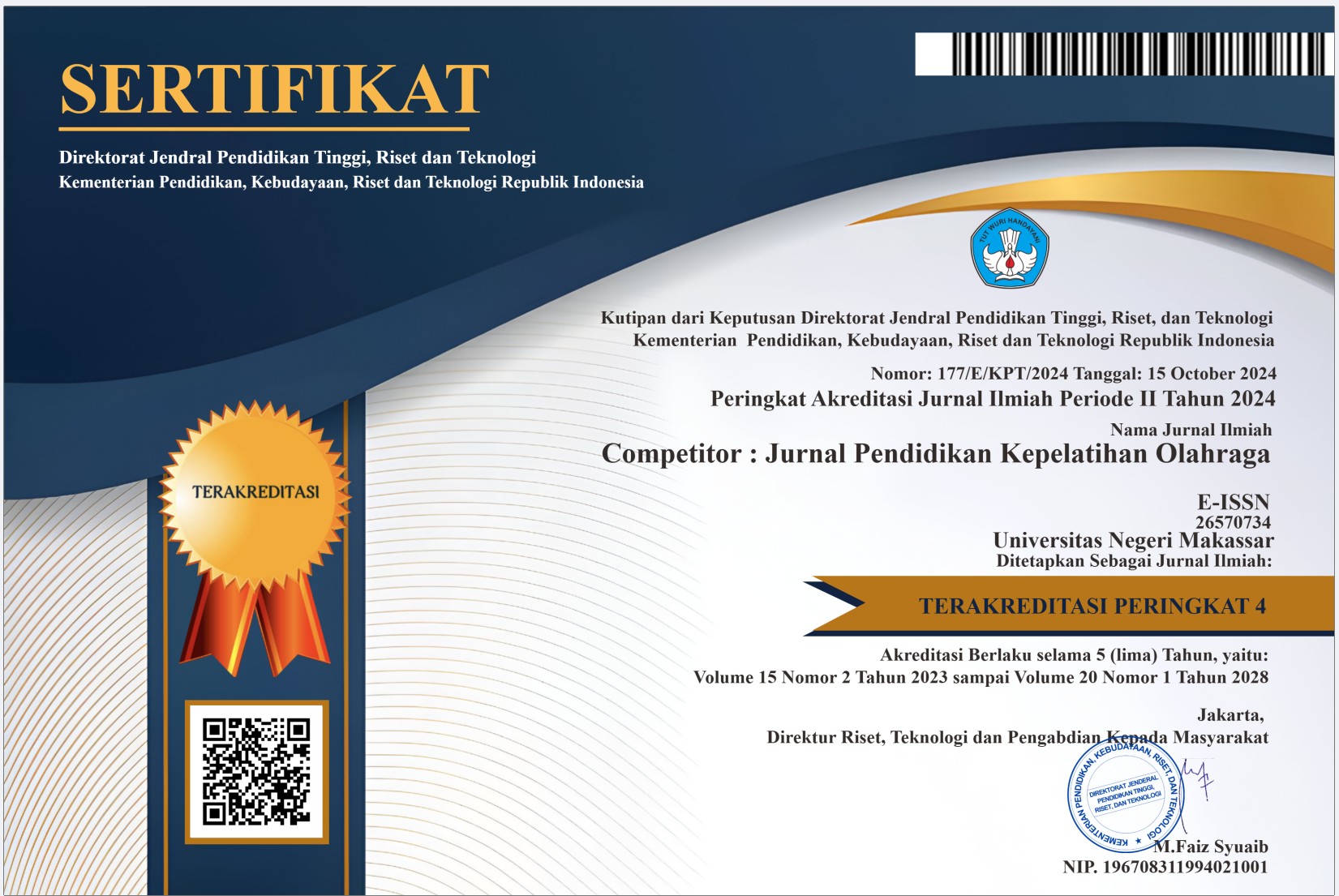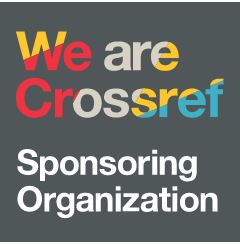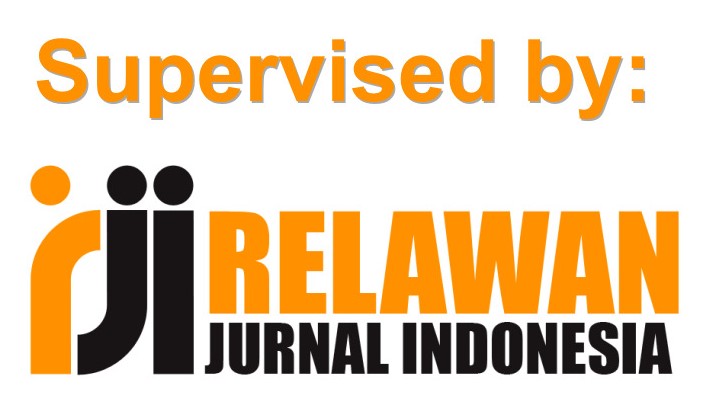Training Intervention Using Sit-Up and Bent Arm Full Over Methods to Improve Lob Shot Execution in Badminton Athletes
DOI:
https://doi.org/10.26858/cjpko.v17i1.73663Keywords:
Badminton Training, Lob Shot, Sit-Up Exercise, Bent Arm Full Over, Muscle Strength.Abstract
This study investigated the effectiveness of a training intervention using sit-up and bent arm full-over methods to improve lob shot execution in badminton athletes at PKO FIKK UNM. A quasi-experimental design with pre-test and post-test control group was employed, involving 20 active badminton athletes divided equally into experimental and control groups. The intervention lasted 6 weeks, with 3-4 training sessions per week focusing on core and shoulder muscle strengthening exercises. Results showed a significant improvement in the experimental group’s lob shot performance. The mean post-test score increased from 70.3 (SD = 5.1) to 85.4 (SD = 4.2), with a paired sample t-test confirming the change as statistically significant (t(9) = 8.72, p < 0.001). Conversely, the control group’s scores showed no significant change (pre-test Mean = 69.8, SD = 4.9; post-test Mean = 71.0, SD = 5.3; t(9) = 1.12, p = 0.29). Independent sample t-tests between groups showed a significant difference in post-test results favouring the experimental group (t(18) = 6.04, p < 0.001). The effect size (Cohen’s d = 1.91) indicated a large practical impact of the training intervention. This study supports the integration of sit-up and bent arm full-over exercises into badminton training programs to enhance lob shot technique through improved muscular strength and control. Future research is recommended to explore long-term effects and applicability to other badminton skills.References
Abdelkrim, N. B., Castagna, C., Jabri, I., Battikh, T., El Fazaa, S., & Ati, J. E. (2014). Activity profile and physiological requirements of junior elite badminton players in singles matches. Journal of Strength and Conditioning Research, 28(7), 1894–1905.
Andersen, L. L., & Aagaard, P. (2010). Influence of strength training on muscle fatigue resistance in skeletal muscle. Scandinavian Journal of Medicine & Science in Sports, 20(1), 47–58.
Badminton Insight. (n.d.). Badminton core exercises - and why this training is important. Retrieved from https://badminton-insight.com/badminton-core-exercises/
Bahr, R. (2016). Why screening tests to predict injury do not work—and probably never will…: A critical review. British Journal of Sports Medicine, 50(13), 776–780.
Behm, D. G., Young, J. D., Whitten, J. H., et al. (2015). Canadian Society for Exercise Physiology position stand: The use of instability to train the core in athletic and nonathletic conditioning. Applied Physiology, Nutrition, and Metabolism, 40(10), 1–14. https://doi.org/10.1139/apnm-2015-0235
Behm, D. G., Drinkwater, E. J., Willardson, J. M., & Cowley, P. M. (2016). The use of instability to train the core musculature. Applied Physiology, Nutrition, and Metabolism, 41(9), 1014–1023.
Bishop, D., Jones, E., & Woods, D. R. (2021). Recovery from training: A brief review. Journal of Strength and Conditioning Research, 35(5), 1313–1321.
Borg, G. (1998). Borg’s Perceived Exertion and Pain Scales. Human Kinetics.
Chaouachi, A., Othman, A., Hammami, R., & Behm, D. G. (2014). Core strength training: A review of the literature. Sports Medicine, 44(9), 1159–1175.
Chow, J. W., Ford-Smith, C., & Tillman, M. D. (2016). Biomechanics of the badminton overhead clear stroke. Sports Biomechanics, 15(2), 121–131.
Creswell, J. W., & Creswell, J. D. (2018). Research Design: Qualitative, Quantitative, and Mixed Methods Approaches. SAGE Publications.
Ellenbecker, T. S., & Roetert, P. (2017). Shoulder injury prevention and rehabilitation in overhead athletes. Journal of Athletic Training, 52(3), 240–249.
Etikan, I., Musa, S. A., & Alkassim, R. S. (2016). Comparison of Convenience Sampling and Purposive Sampling. American Journal of Theoretical and Applied Statistics, 5(1), 1–4. https://doi.org/10.11648/j.ajtas.20160501.11
Ferioli, D., Campa, F., & Mascherini, G. (2020). Effects of plyometric training on badminton players’ performance: A systematic review. International Journal of Sports Physiology and Performance, 15(5), 689–700.
Ferrari, M., Gabbett, T., & Di Michele, R. (2020). Effects of core training on stroke velocity in tennis players. Journal of Sports Sciences, 38(6), 662–668.
Field, A. (2018). Discovering Statistics Using IBM SPSS Statistics (5th ed.). SAGE Publications.
Gabbett, T., Nassis, G. P., Oetter, E., & Johnston, N. (2016). Strategies for injury prevention in badminton. British Journal of Sports Medicine, 50(18), 1065–1067.
García-González, J., Fernández-Cuevas, I., & Pérez-Soriano, P. (2019). Psychological and tactical aspects in badminton performance: A systematic review. International Journal of Sports Science & Coaching, 14(5), 700–712.
Hadjarati, H., Haryanto, A. I., Prasetyo, A., & Ilham, A. (2023). Distribution practice method of badminton lob punch accuracy. Jurnal Olahraga Prestasi, 19(3), 123–130. https://doi.org/10.21831/jorpres.v19i3.37054
Justin, B. (n.d.). 5 badminton core exercises to boost stability and strength. Retrieved from https://www.badmintonjustin.com/training-and-drills/5-badminton-core-exercises-to-boost-stability-and-strength
MDPI. (2021). The effect of eight-week sprint interval training on aerobic performance of elite badminton players. International Journal of Environmental Research and Public Health, 18(2), 638. https://doi.org/10.3390/ijerph18020638
Ma, S., Soh, K. G., Japar, S. B., Xu, S., & Zhicheng, G. (2024). Maximizing the performance of badminton athletes through core strength training: Unlocking their full potential using machine learning (ML) modelling. Heliyon, 10(15), e35145. https://doi.org/10.1016/j.heliyon.2024.e35145
Maskun, M. R. A., Khaeroni, & Setiawan, I. (2023). Extracurricular students' lob shot accuracy was improved by drilling training and the patterned strokes method. Musamus Journal of Physical Education and Sport (MJPES), 6(1), 224–233. https://doi.org/10.35724/mjpes.v6i1.5532
Palinkas, L. A., Horwitz, S. M., Green, C. A., Wisdom, J. P., Duan, N., & Hoagwood, K. (2015). Purposeful Sampling for Qualitative Data Collection and Analysis in Mixed Method Implementation Research. Administration and Policy in Mental Health and Mental Health Services Research, 42(5), 533–544. https://doi.org/10.1007/s10488-013-0528-y
Phomsoupha, M., & Laffaye, G. (2015). The Science of Badminton: Game Characteristics, Anthropometry, Physiology, Visual Fitness and Biomechanics. Sports Medicine, 45(4), 473–495. https://doi.org/10.1007/s40279-014-0287-2
PMC. (2024). Maximizing the performance of badminton athletes through core strength training: Unlocking their full potential using machine learning (ML) modelling. Retrieved from https://pmc.ncbi.nlm.nih.gov/articles/PMC11334617/
PubMed. (2024). Effect of core strength training on the badminton player's performance: A systematic review & meta-analysis. Retrieved from https://pubmed.ncbi.nlm.nih.gov/38865415/
ResearchGate. (2024). Effect of core strength training on the badminton player's performance: A systematic review & meta-analysis. Retrieved from https://www.researchgate.net/publication/381350750_Effect_of_core_strength_training_on_the_badminton_player's_performance_A_systematic_review_meta-analysis
Siby, D., Rajkumar, N. C. J., Astuti, Y., & Orhan, B. E. (2016). Effect of core strength training on dynamic balance and agility in adolescent badminton players. Journal of Physical Education and Sport, 16(3), 910–915. https://doi.org/10.7752/jpes.2016.03144
Siedentop, D., & Tannehill, D. (2020). Developing Teaching Skills in Physical Education. McGraw-Hill Education.
Suchomel, T. J., Nimphius, S., & Stone, M. H. (2016). The Importance of Muscular Strength in Athletic Performance. Sports Medicine, 46(10), 1419–1449. https://doi.org/10.1007/s40279-016-0486-0
Tabachnick, B. G., & Fidell, L. S. (2019). Using Multivariate Statistics (7th ed.). Pearson Education.
Thomas, J. R., Nelson, J. K., & Silverman, S. J. (2015). Research Methods in Physical Activity (7th ed.). Human Kinetics.
Downloads
Published
Issue
Section
License
Copyright (c) 2025 Muhammad Ishak, Andi Ridwan, Awaluddin Awaluddin (Author)

This work is licensed under a Creative Commons Attribution 4.0 International License.





















